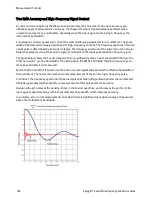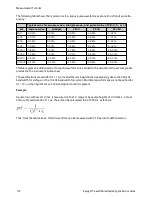
Estimating High–Frequency (Out–of–Band) Error
A common way to describe signal waveshapes is to refer to their "Crest Factor". Crest factor is the ratio of
the peak value to rms value of a waveform. For a pulse train, for example, the crest factor is approximately
equal to the square root of the inverse of the duty cycle.
Notice that crest factor is a composite parameter, dependent upon the pulse width and repetition fre-
quency; crest factor alone is not enough to characterize the frequency content of a signal.
Traditionally, DMMs include a crest factor derating table that applies at all frequencies. The measurement
algorithm used in the True
volt
Series DMMs is not inherently sensitive to crest factor, so no such derating
is necessary. With this multimeter, as discussed in the previous section, the focal issue is high–frequency
signal content which exceeds the multimeter’s bandwidth.
For periodic signals, the combination of crest factor and repetition rate can suggest the amount of high–
frequency content and associated measurement error. The first zero crossing of a simple pulse occurs at f
1
= 1/t
p
.
This gives an immediate impression of the high-frequency content by identifying where this crossing
occurs as a function of crest factor: f
1
=(CF
2
)(prf).
Keysight True
volt
Series Operating and Service Guide
169
Measurement Tutorial















































